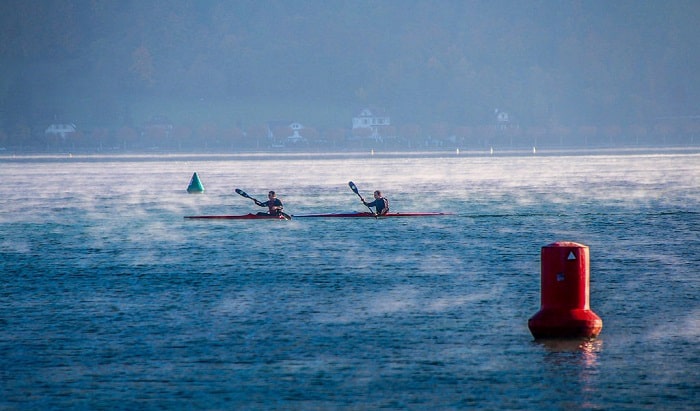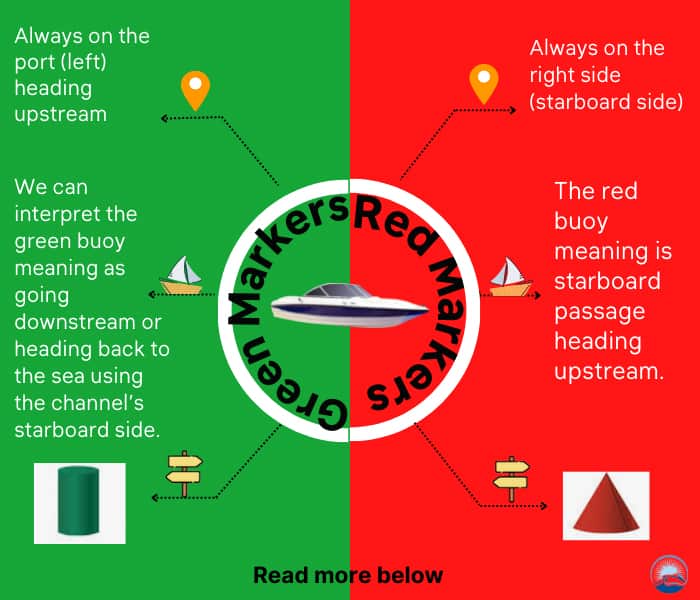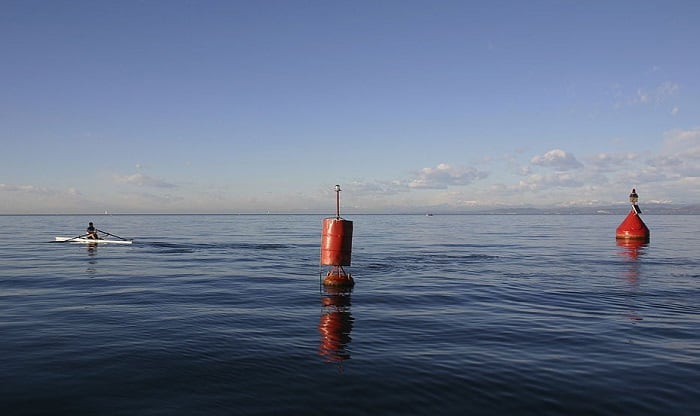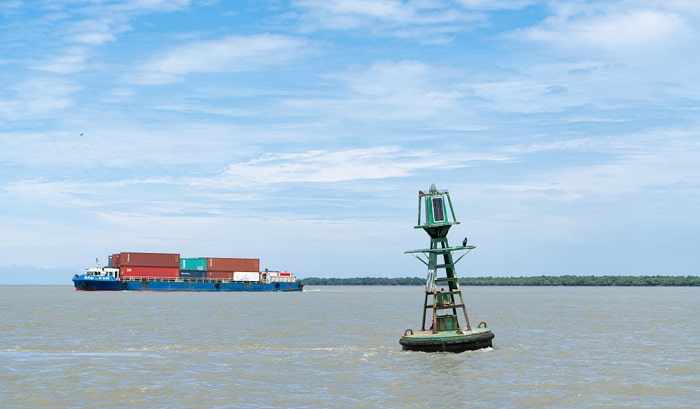Do you find channel markers so confusing that it becomes difficult to choose which side of the waterway you should pilot your boat in? Navigating your watercraft should be a cinch if you know the answer to the question, ‘what do the red and green markers indicate?’
Like lane dividers in highways, navigational channel markers exist in red and green to allow you and other boaters to move along the waterway safely. If you still find that confusing, this article should help clarify things.
Table of Contents
What Do the Colors Indicate
The red and green boating markers show you which side of a waterway you should pilot your boat in, depending on your direction. They are straightforward to use.
1. Red
A red marker is always on the right side (starboard side) of the waterway. It marks where you should pilot your boat heading inland from the open sea or going upstream.
Upstream refers to the inland flow of water coming from the sea. On the other hand, downstream is boat movement towards open water.
Hence, when you head back to the sea from the marina, the red marker will be on the port side (left side) or your left side.
In short, the red buoy meaning is starboard passage heading upstream.
2. Green
If red is on the starboard (right) side of a waterway, green is always on the port (left) heading upstream.
Hence, when you decide to head back into the open waters from the marina, you will be passing on your starboard (right) side.
I know it gets confusing because red is supposed to be on the starboard side.
However, I must remind you that our reference here is heading back inland from the sea. So, whenever returning from open waters, red will always be on the right side.
Hence, we can interpret the green buoy meaning as going downstream or heading back to the sea using the channel’s starboard side.
What If the Marker Has Both Green and Red Colors
You now know what a red or green buoy means. However, what if you see a buoy with red and green bands?
Buoys with green and red bands are bifurcation markers, informing you of diverging water channels ahead.
While having two colors on a single buoy can be confusing, you should always focus on the topmost color. This color tells you the preferred or recommended channel to navigate your boat.
For example, if the buoy is red over green, you should stick to the starboard side because it is the preferred channel. If you pilot your boat to the left or port side, you navigate in the secondary channel.
How About the Shapes of the Markers
Some people may not be able to differentiate green from red or appreciate the colors. That is why these navigational aids also come in different shapes.
Red buoys often have a triangular shape. People call these markers ‘daymarks.’ There are also red channel buoys with a cylindrical body and a cone-shaped top. We know these as nun buoys.
Meanwhile, green daymarks have green squares. Green buoys can also have a cylindrical body but with a flat top, collectively called can buoys.
The combination of marker shape and color should make identification and interpretation more convenient and foolproof.
What If There are Numbers in the Buoys
Channel buoys also have numbers printed on their surfaces. These numbers indicate the buoy’s distance to the open water. The smaller the number, the closer you are to the open sea. Conversely, the larger the number, the farther you are from the open waters.
Red buoys have even numbers, such as 2, 8, and 10. Meanwhile, green channel markers have odd numbers, like 3, 7, and 13.
As such, when heading upstream, you may notice the numbers on the red buoys increasing. On the other hand, when you go back to the open waters from the dock, the green buoys will have decreasing numbers.
There is another use for these numbers. They can give you an idea of where you are heading.
For example, if you read the number ‘8’ on a red buoy and the next marker has the number ’12,’ you know you are moving away from the sea.
Knowing the numbers’ significance is essential because intracoastal waterways are like inner-city roads and neighborhood streets. They branch into several channels or connect to other waterways.
It would be easy to lose your bearing if you do not know how to interpret the numbers on these channel markers.
What Other Important Markers You Should Know
Green and red buoys are not the only navigational aids every boater must know to navigate water channels safely. You also need at least two more markers.
1. Mooring Buoy
You can consider these buoys the equivalent of parking slots. They float on the water, providing people with a platform for ‘parking’ or mooring their boats.
Mooring buoys eliminate the need for deploying anchors, which can damage delicate corals and other fish habitats. These markers also prevent larger watercraft from running aground.
In terms of mooring buoy colors, they always come in bright orange bands on a white background. The color should make the buoy effortless to spot.
2. Safe Water Buoy
Easy to spot and interpret, a safe water buoy marks that section of the water channel where you can safely navigate your boat. In most cases, you can see them in the middle of the waterway.
The buoy has a two-color paint scheme, split vertically between red and white. It should make navigating the water channel less confusing.
Conclusion
So, what do the red and green markers indicate? The green cylindrical buoys with a flat top section or green square boards designate that part of the waterway going back to the sea. They also have odd numbers in decreasing value the closer you get to the open waters.
On the other hand, the even-numbered red triangles or cylindrical markers with a conical top indicate that part of the water channel heading inland from the sea. As you go farther away from the open waters, the numbers increase.
With this information, you should be able to navigate the water channels safely and confidently.

I am passionate about water sports and technical fields, so combining both makes me interested in making contents about boat accessories. With my partner, we went on many trips and sports games together, which led us to think about how we can spread our joys and passions to many people.




